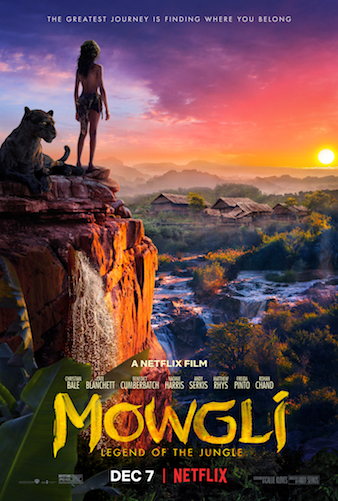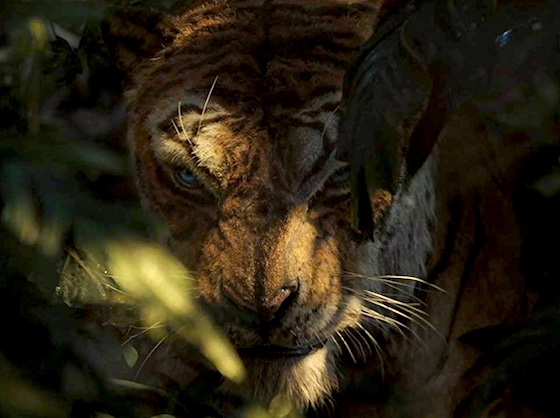Andy Serkis | 104 mins | streaming (HD) | 2.39:1 | UK & USA / English & Hindi | 12 / PG-13

Hollywood has a long history of different people coming up with the same idea resulting in competing films — asteroid-themed Armageddon and Deep Impact is perhaps the best-known example. But often when the ideas are too similar, one of the projects gets scrapped — Baz Luhrmann ditched plans for an Alexander the Great biopic once Oliver Stone’s got underway, for instance. When Disney and Warner Bros both announced CGI-driven live-action adaptations of Rudyard Kipling’s The Jungle Book, I don’t know about anyone else, but I figured one studio would blink and we’d end up with just one film. That didn’t happen, and both movies entered production around the same time, and were even originally scheduled to come out the same year. In this respect it was Warner who blinked first, putting their version back to allow more time to finesse the motion-capture-driven animation, while Disney got theirs out on schedule. Unfortunately for Warner, it was a huge hit with critics and audiences alike, putting their version in a rather precarious position.
So when the news broke that Mowgli (as the film had been retitled to help distance it from Disney’s) was to be released direct to Netflix, well, I don’t think anyone was surprised: the streaming service has become a regular dumping ground for movies that studios have lost confidence in, seemingly happy to pay for any castoff a major studio throws their way. Apparently that’s not what went down this time, though: Mowgli had a theatrical release date set and the promotional campaign had begun, when Netflix approached Warner saying they loved the film and wanted to buy it. I guess the certainty of a large Netflix payday vs. the gamble of box office success on a film that could be seen by the general public as a Johnny-come-lately cash-in rip-off was an easy choice for Warner to make. And so here we are.

Mowgli (as it’s always called in the film itself, the subtitle presumably being a Netflix marketing addition) has a story that will be broadly familiar to anyone who’s seen any other version of The Jungle Book, most especially that recent Disney one: the eponymous boy is orphaned when his parents are murdered by man-eating tiger Shere Khan, but he’s rescued by black panther Bagheera, who takes him to be raised by a pack of wolves. Shere Khan wants to kill the man-cub, however, and looks for an opportunity to separate him from the wolves’ protection. The difference, then, lies in the details: where Disney’s version was PG-rated and family-friendly, director Andy Serkis has given this a darker, PG-13 spin. It’s not an Adult movie by any means, but it’s definitely suited to slightly older children. That said, there’s a revelation at the 80-minute mark which is horrendously misjudged, and is liable to upset children of all ages (i.e. including some adults too).
That moment aside, the film’s more realistic tone manifests in multiple ways. One is characterisation, most notably of the bear Baloo. As we know him from Disney’s takes, he’s decidedly laid-back and chummy, casually teaching Mowgli some ways of the jungle. Here, he’s more of a drill sergeant for the wolf pack, explicitly training Mowgli (and his wolf brothers) in the skills required to fully join the pack. He has a softer side — he definitely cares for the man-cub — but this never manifests in the Disney-ish way. Elsewhere, there’s a drive at some kind of psychological realism for our hero. With Mowgli driven out for his own safety (again, an example of the animal characters being somewhat harsher than in Disney), he ends up in a human village. There, he comes to realise he doesn’t truly belong in the world of animals… but nor does he truly belong in the world of men. This internal conflict about his place in the world comes to underpin the climax, and arguably makes it superior to the over-elaborate forest-fire spectacle of Disney’s film.

The realism extends to the overall visual style, too. Where Disney’s live-action version was all shot on L.A. sound stages, with the young actor playing Mowgli frequently the only real thing on screen, Serkis and co travelled overseas and actually built sets on location to shoot a significant portion of the film. Accompanied by cinematography that often goes for a muted colour palette, it seems clear the aim was to make a film that is perhaps not “darker” in the now-somewhat-clichéd sense, but more grounded and less cartoonish than certain other adaptations.
Unfortunately, Serkis made one design decision that threatens to scupper the entire endeavour: having motion-captured famous actors for most of the animal roles (including the likes of Christian Bale, Benedict Cumberbatch, Cate Blanchett, Tom Hollander, Peter Mullan, Eddie Marsan, Naomie Harris, and, of course, Serkis himself), someone thought it would be a good idea to try to integrate the actors’ features into the animal faces. The result is… disturbing. There’s so much realism in the overall design, but then they have these faces that are part realistic, part cartoon, part like some kind of grotesque prosthetic. It is so bad that it genuinely undermines the entire movie, for two reasons: one, it’s a distraction, making you constantly try to parse what you’re watching and how you feel about it; and two, a more serious take on the material asks for us to make a more serious connection to the characters, and that’s hard when they look so horrid. The section in the human village — which, by rights, should be “the boring bit” because it doesn’t involve fun animal action — is probably the film’s strongest thanks to its location photography and real actors making it so much more tangible. It suggests how much more likeable the entire film would be if they’d gone for real-world-ish animal designs — like, ironically, the Disney film did. (Now, that might’ve got away with cartoonish semi-human animals thanks to its lighter tone. Or it might not, because these are monstrous.)

It sounds petty to pick one highly specific element and say it ruins the film, but I really felt like it did. It’s a barrier to enjoying the bits that work (Rohan Chand is often superb as Mowgli; the always-brilliant Matthew Rhys is brilliant as always; there’s some welcome complexity and nuance to several characters and situations), and therefore it does nothing to help gloss over any other nits you want to pick (Serkis is miscast; Frieda Pinto is completely wasted; Cumberbatch is a little bit Smaug Mk.II; that revelation I mentioned back in paragraph three is brutal and I can’t believe it was okayed by the studio). Also, on a somewhat personal note, I felt there were times you could tell Serkis had made the film in 3D, but Netflix haven’t bothered to release it in that format (outside of some very limited theatrical screenings) — as someone who owns a 3D TV because, you know, I enjoy it, that miffed me.
On the whole, Mowgli: Legend of the Jungle is a frustratingly imperfect experience. I believe it’s fundamentally a unique-enough variation on the material that it could’ve escaped the shadow of Disney’s film, but a few misguided creative decisions have dragged it down almost irreparably.

Mowgli is available on Netflix worldwide now.

Really curious about this, I think I might enjoy its darker sensibilities (and lack of Disney songs) but it does seem ill-timed. Mind, I already think that HBOs Watchmen series is being done too soon to the movie, and that’s nearly ten years ago now.
Your comments regards the motion-capture is either alarming or exciting. Serkis is one of the most experienced actors with motion-capture and virtual characters, so you’d think he’d know what he was doing. On the one hand it does seem exciting and novel, but your comments on how weird it looks is definitely alarming. I would have thought you’d do everything you could to try make the CGI not look fake or strange and part of that would be in not drawing attention to it.
LikeLiked by 1 person
I can see why Serkis probably thought doing mo-cap would benefit his cast, especially after having played an animal himself in Planet of the Apes — he was probably trying to get more physicality in their voices, to avoid that “actor in a sound booth” sound of poor (or even just regular) voice acting. But humans can’t convincingly recreate the body movements of big cats, wolves, etc, so why bother?! And the face capture… yeah, it just hasn’t worked. So, basically, I can see his thinking, but it’s a shame he didn’t realise it wasn’t working, write it off to experience, and go with more realistic faces.
LikeLike